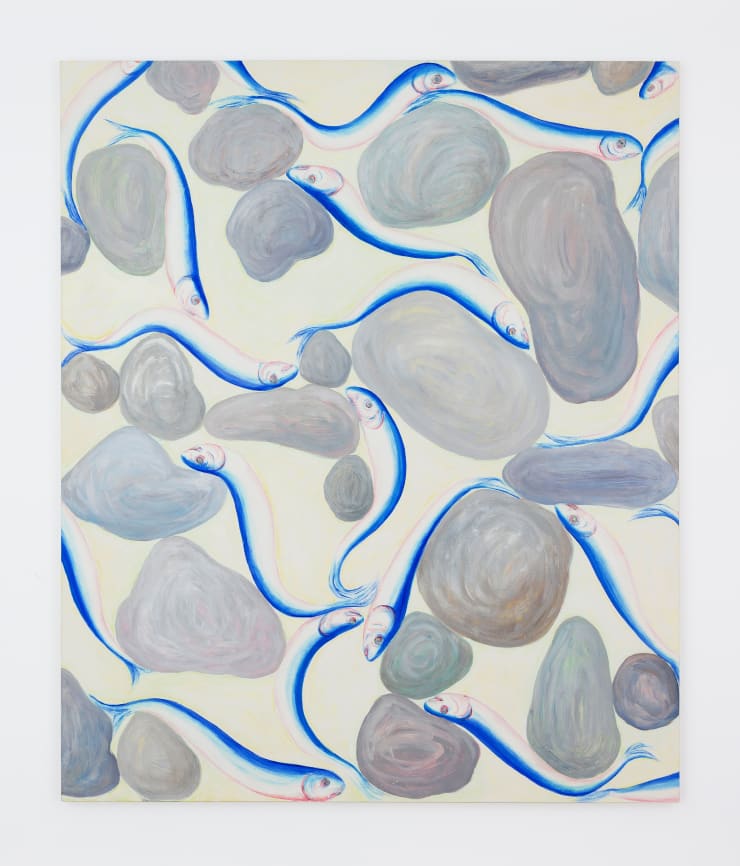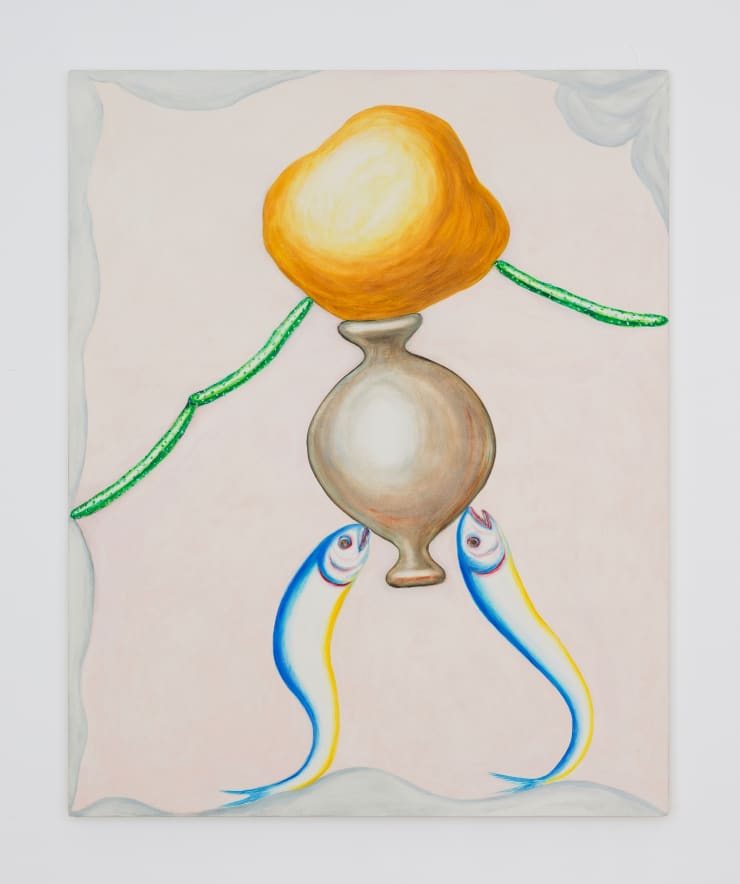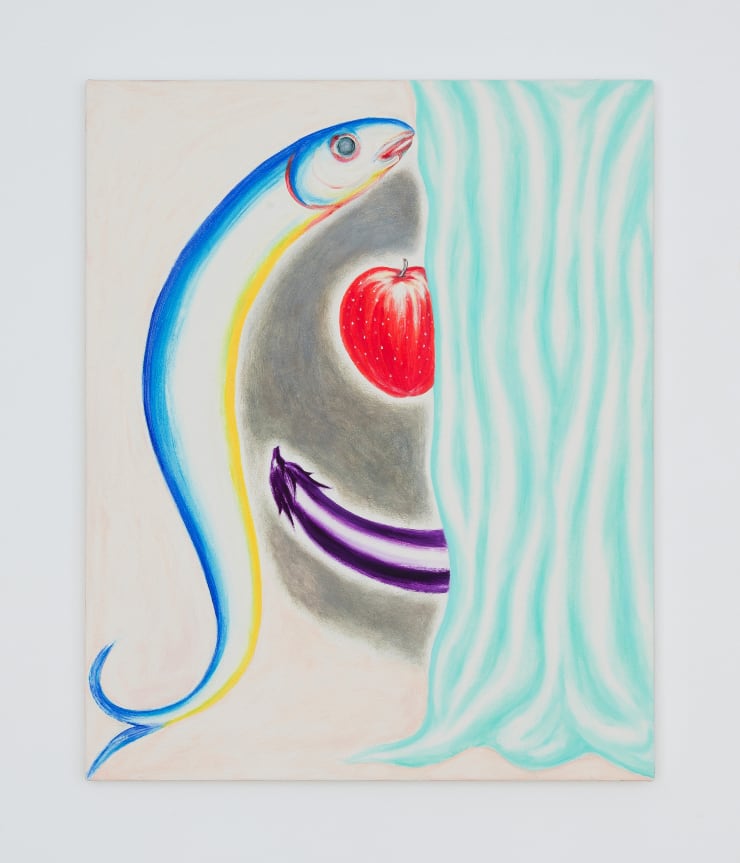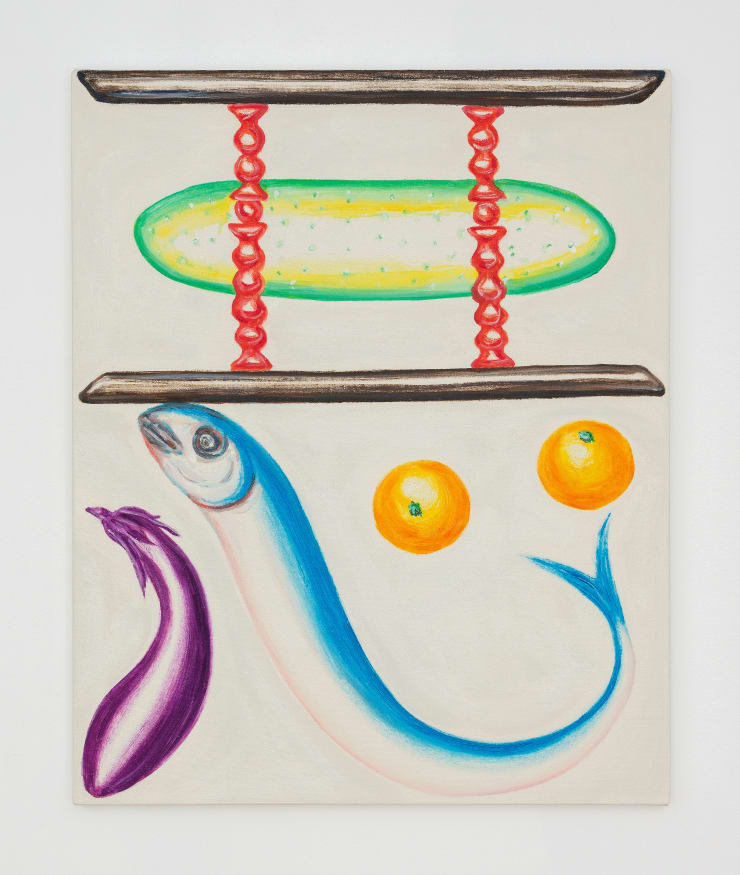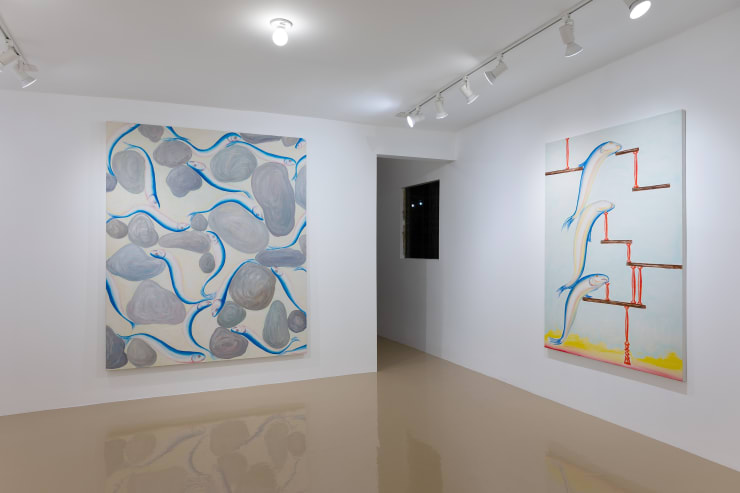Shigeru Hasegawa: painting
6917 Melrose Avenue Los Angeles CA 90038
Open hours: 12PM-7PM
–– Shigeru Hasegawa
At our Melrose Avenue gallery, Nonaka-Hill is delighted to present painting, selected work by Shigeru Hasegawa (Japan, b. 1963), marking his first solo exhibition outside of Japan. Latently informed by Japanese ukiyo-e, manga, and various Western painting traditions, Hasegawa’s idiosyncratic works feature a recurring cast of fruits, vegetables, fish, and other objects. Arranging them into formations against the picture plane, Hasegawa makes playfully concentrated paintings, executing each one with formal economy. Receiving his art training in Japan, Germany, and Holland in the 1980s and 1990s, Hasegawa was exposed to a wide range of formative influences, which for the past two decades, he has diffused into his unusually fresh paint handling and surfaces. His orchestration of objects in stacks and patterns thus take on a provisional and animated appearance, as if they could fall apart or rearrange themselves at will. In two paintings on view, vegetables and fish assume the shapes of various Kanji, Chinese-derived characters in the Japanese writing system, one of which features two swollen eggplants aligned to signify “person.” In several other paintings, his formations resemble a schematic figure, somewhat similar to how 16th century artist Giuseppe Arcimboldo’s rendered human subjects as combinations of fruits and vegetables. Such allusions to the transience of life, as memento mori and vanitas, abound in Hasegawa’s work. But in the same spirit as Arcimboldo, his work possesses a whimsical obscurity as to what each part distinctly symbolizes. That a kindred use of vegetables can be found in Itō Jakuchū’s 18th century painting, Scene of Buddha’s Nirvana by Vegetables, has not been lost on Hasegawa either. He knows that even the Buddha can be represented by a radish. Yet, his paintings are not limited to such readings because his symbols are fugitive, and his means of their articulation in as few brushstrokes as possible, is his focus beyond motifs.
This provisional nature also finds itself in how Hasegawa refers to the beginning of a painting, conceptualizing it as a confrontation with a screen or mirror. In his approach to distill his ideas into paint, it is similar to the Zen discipline of Zazen, a practice whose objective is its own process, beyond it being seen by the public. In one of his paintings in the exhibition, one sees a grey-blue expanse in its center framed by many overlapping cucumbers. The expanse is vaguely in the shape of a human head, in which one can maybe discern facial features. It could be a suggestion for the way one looks, or Hasegawa looks, at the inner-self––an attempt to become nothing, like Zazen.
Shigeru Hasegawa’s solo exhibitions include Satoko Oe Gallery, Tokyo, Japan (2022 – 2019); memento mori-kun, Shouonji-temple,Tokyo (2021); Galleria Fienarte, Aichi, Japan (2020); Open Studio 49–What is the motif?! Fuchu Art Museum, Tokyo, Japan (2010); and group exhibitions at Museum Haus Kasuya, Kanagawa, Japan (2022); Toyota Municipal Museum of Art, Aichi, Japan (2019); Aichi Prerfectural Museum of Art, Aichi, Japan (2019); Okazaki Mindscape Museum, Aichi, Japan (2013); The National Museum of Art, Osaka, Japan (2010); National Gallery of Modern Art, New Delhi, India (2005)
-
 Shigeru HasegawaOil on cotton76 3/8 x 63 3/4 in
Shigeru HasegawaOil on cotton76 3/8 x 63 3/4 in
194 x 162 cm -
 Shigeru HasegawaThe Sower (female), 2020-2021Oil on cotton63 3/4 x 51 1/8 in
Shigeru HasegawaThe Sower (female), 2020-2021Oil on cotton63 3/4 x 51 1/8 in
162 x 130 cm -
 Shigeru HasegawaThe Sower (male), 2020Oil on cotton63 3/4 x 51 1/8 in
Shigeru HasegawaThe Sower (male), 2020Oil on cotton63 3/4 x 51 1/8 in
162 x 130 cm -
 Shigeru HasegawaOil on cotton63 3/4 x 44 1/8 in
Shigeru HasegawaOil on cotton63 3/4 x 44 1/8 in
162 x 112 cm -
 Shigeru HasegawaOil on cotton31 5/8 x 25 5/8 in
Shigeru HasegawaOil on cotton31 5/8 x 25 5/8 in
80.3 x 65.2 cm -
 Shigeru HasegawaOil on cotton20 7/8 x 17 7/8 in
Shigeru HasegawaOil on cotton20 7/8 x 17 7/8 in
53 x 45.5 cm -
 Shigeru HasegawaOil on cotton28 3/4 x 24 in
Shigeru HasegawaOil on cotton28 3/4 x 24 in
73 x 60.8 cm -
 Shigeru Hasegawa堀損樽−婆痴軽 参 horizontal - vertical three, 2012Oil on cotton51 1/4 x 38 1/4 in
Shigeru Hasegawa堀損樽−婆痴軽 参 horizontal - vertical three, 2012Oil on cotton51 1/4 x 38 1/4 in
130.3 x 97 cm -
 Shigeru HasegawaMedusa, 2020Oil on cotton31 5/8 x 25 3/4 in
Shigeru HasegawaMedusa, 2020Oil on cotton31 5/8 x 25 3/4 in
80.3 x 65.5 cm -
 Shigeru HasegawaOil on cotton17 7/8 x 15 in
Shigeru HasegawaOil on cotton17 7/8 x 15 in
45.5 x 38.2 cm -
 Shigeru Hasegawa悪 / evil, 2022Oil on cotton25 3/4 x 20 7/8 in
Shigeru Hasegawa悪 / evil, 2022Oil on cotton25 3/4 x 20 7/8 in
65.4 x 53 cm -
 Shigeru Hasegawa法被威切屠 - 壱 / happy set 1, 2020-2021Oil on cotton20 7/8 x 16 3/8 in
Shigeru Hasegawa法被威切屠 - 壱 / happy set 1, 2020-2021Oil on cotton20 7/8 x 16 3/8 in
53 x 41.5 cm

